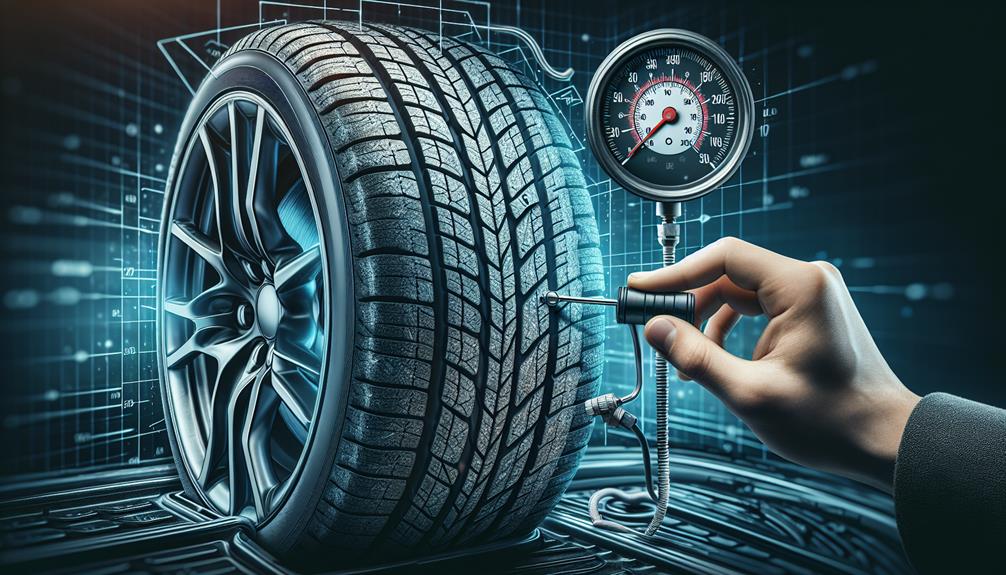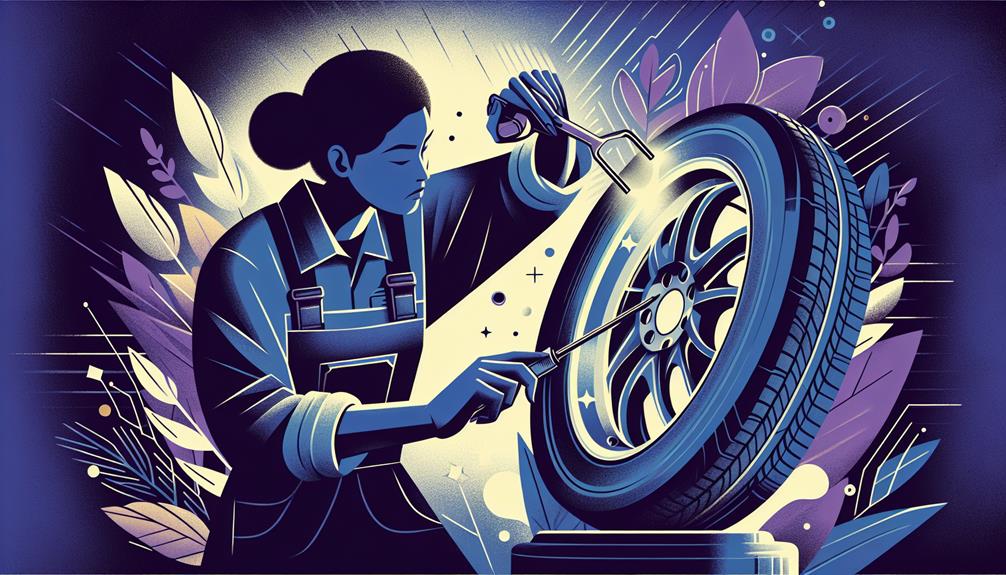Imagine your car as a well-oiled machine, with each component playing a vital role in its smooth operation. Now, picture your tires as the foundation of this machine, bearing the weight and ensuring its stability on the road.
Just like any other part, they too require proper care and attention to maximize their lifespan. So, how can you achieve this? The answer lies in one key factor: proper alignment.
But why is alignment so crucial, and how does it impact the longevity of your tires? Stay tuned to uncover the secrets that will not only keep your tires rolling smoothly but also save you from unnecessary expenses and headaches down the road.
Key Takeaways
- Proper alignment is crucial for maximizing the lifespan of tires.
- Signs of misalignment include uneven tire wear, pulling to one side while driving, and steering wheel vibrations.
- Proper alignment reduces the risk of tire damage and improves vehicle handling and performance.
- Seeking professional help may be necessary for optimal alignment results and to prevent premature tire wear, poor fuel efficiency, and compromised safety.
The Impact of Wheel Alignment on Tire Lifespan
Proper wheel alignment plays a crucial role in maximizing the lifespan of your tires. Alignment techniques aimed at maximizing tire longevity are essential for maintaining the overall performance and durability of your tires. Regular alignment checks are of utmost importance to ensure that your tires wear evenly and last as long as possible.
When your wheels are properly aligned, it means that they're positioned at the correct angles relative to each other and to the road. This alignment ensures that the tires make optimal contact with the road surface, minimizing unnecessary wear and tear. When your wheels are misaligned, certain areas of the tires may experience excessive friction and wear, leading to premature deterioration.
Regular alignment checks help detect and correct any misalignment issues early on. By addressing these issues promptly, you can prevent uneven tire wear, which can significantly shorten their lifespan. Regular alignment checks also contribute to improved vehicle handling and fuel efficiency, as properly aligned wheels reduce rolling resistance and ensure optimal traction.
Signs of Misalignment: How to Identify the Problem
To identify signs of misalignment, carefully observe the wear patterns on your tires. Misalignment can have various causes and can lead to premature tire wear and reduced tire lifespan. Here are three common signs of misalignment that you should be aware of:
- Uneven Tire Wear: When your tires are misaligned, they may wear unevenly. Look for signs such as excessive wear on the inner or outer edges of the tire tread. Uneven wear can indicate that the tires aren't making proper contact with the road, which is often a result of misalignment.
- Pulling to One Side: If your vehicle pulls to one side while driving on a straight road, it could be a sign of misalignment. This pulling sensation occurs because the tires aren't pointing in the same direction. Common causes of pulling include misadjusted toe, camber, or caster angles.
- Steering Wheel Vibrations: Misalignment can also cause vibrations in the steering wheel. If you feel vibrations while driving, especially at higher speeds, it may indicate that the tires aren't aligned correctly. This can be caused by imbalances in the tire or wheel assembly, as well as misalignment.
To avoid these issues and maximize tire lifespan, it's important to address misalignment promptly. Regular wheel alignments are essential preventative measures. By keeping your wheels properly aligned, you can ensure even tire wear, improve vehicle handling, and extend the lifespan of your tires.
The Benefits of Proper Alignment for Tire Wear
When addressing misalignment promptly, you can experience the benefits of proper alignment for tire wear. Proper alignment plays a crucial role in increasing tire longevity and ensuring optimal tire performance.
One of the key benefits of maintaining proper alignment is that it helps distribute the weight of your vehicle evenly across all four tires. When your vehicle is misaligned, certain tires bear more weight than others, leading to uneven tire wear. By addressing misalignment, you can prevent this uneven wear and extend the lifespan of your tires.
Proper alignment also reduces the risk of tire damage. Misalignment can cause your tires to scrub against the road surface at an angle, causing excessive friction and wear. This can lead to premature tire failure and the need for costly replacements. By aligning your tires properly, you minimize the risk of tire damage and extend their lifespan.
Furthermore, proper alignment improves your vehicle's handling and overall performance. When your tires are aligned correctly, they can maintain proper contact with the road, ensuring optimal traction and stability. This not only enhances your safety on the road but also improves fuel efficiency and reduces tire rolling resistance, resulting in better overall performance.
Aligning Your Wheels: The Steps to Take
To align your wheels accurately and effectively, follow these step-by-step instructions:
- Prepare the vehicle:
- Park on a level surface and set the parking brake.
- Ensure the tires are properly inflated and in good condition.
- Remove any excess weight from the vehicle.
- Measure and adjust the toe:
- Use a measuring tape to measure the distance between the front and rear edges of the tires on both sides.
- Compare the measurements and adjust the tie rod ends accordingly.
- Aim for a slight toe-in or toe-out, depending on the vehicle's specifications.
- Check and adjust the camber and caster:
- Use a camber gauge and caster angle gauge to measure the angles of the wheels.
- Compare the measurements to the manufacturer's specifications and adjust if necessary.
- Use camber shims or adjustable control arms to fine-tune the camber and caster angles.
Wheel alignment is of utmost importance to ensure even tire wear, improved handling, and vehicle stability. While a professional alignment is recommended for optimal results, a DIY wheel alignment can be attempted with caution.
However, it's crucial to note that improper alignment can lead to premature tire wear, poor fuel efficiency, and compromised safety. If you're unsure about performing a wheel alignment yourself, it's best to seek the expertise of a qualified technician.
Professional Wheel Alignment: When to Seek Help
After successfully aligning your wheels using the steps mentioned above, it's important to know when to seek professional help for a wheel alignment. While performing a DIY wheel alignment can save you money, there are certain situations where seeking professional assistance is necessary.
One key factor to consider is the cost. Professional wheel alignment services may come with a price tag, but it's essential to weigh this against the potential risks and expenses of improper alignment. If you lack experience or the necessary tools for a proper alignment, attempting it yourself could lead to further damage and costly repairs down the line.
Additionally, if you notice persistent issues with your vehicle's alignment despite your best efforts, it may be time to seek professional help. Uneven tire wear, steering wheel vibrations, or a consistent pull to one side can indicate underlying problems that require expert attention. Trying to address these issues on your own without the proper knowledge and equipment could worsen the situation.
Frequently Asked Questions
How Often Should I Get My Wheels Aligned?
You should get your wheels aligned regularly to maximize tire lifespan. Regular alignment maintenance offers benefits such as improved fuel efficiency and better handling. Signs that indicate the need for alignment include uneven tire wear and the vehicle pulling to one side.
Can Misalignment Cause Uneven Tire Wear?
Misalignment can cause uneven tire wear, leading to premature tire damage. Regular tire rotations are crucial in preventing this. To maximize tire lifespan, it is important to address misalignment promptly and ensure regular maintenance.
Can I Align My Wheels Myself, or Should I Always Seek Professional Help?
You should always seek professional help for wheel alignment. DIY wheel alignment may lead to improper alignment, which can result in uneven tire wear and reduce the lifespan of your tires. Professional alignment services offer the expertise and precision needed to maximize tire lifespan.
What Are Common Causes of Wheel Misalignment?
Common causes of wheel misalignment include hitting potholes, curbs, or objects on the road, as well as worn suspension components. This can lead to uneven tire wear, decreased fuel efficiency, and compromised vehicle handling.
Will Proper Alignment Improve Fuel Efficiency?
Proper alignment improves fuel efficiency by reducing rolling resistance and optimizing tire contact with the road. Regular maintenance and alignment checks are essential for improving vehicle performance and maximizing the benefits of regular maintenance.
Conclusion
In conclusion, proper wheel alignment plays a crucial role in maximizing tire lifespan. By identifying signs of misalignment and taking the necessary steps to align your wheels, you can ensure that your tires wear evenly and last longer.
Seeking professional help when needed further guarantees optimal alignment. Don't underestimate the impact of alignment on tire wear – it could be the key to extending the lifespan of your tires and saving you money in the long run.
- How Much Does a Ford 9N Tractor Weigh - May 20, 2024
- How Many of My Exact Car were Made: Uncovering the Rarity - May 20, 2024
- How to Find Out What Someone Drives: Discover the Truth - May 20, 2024



